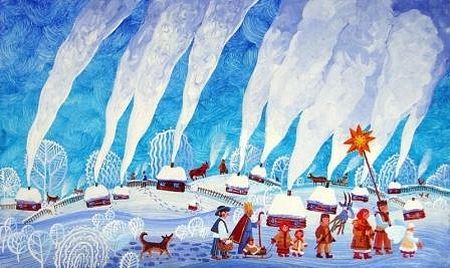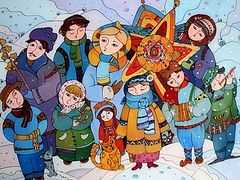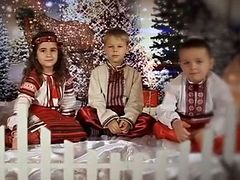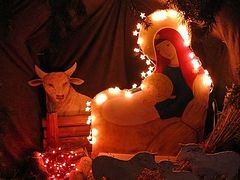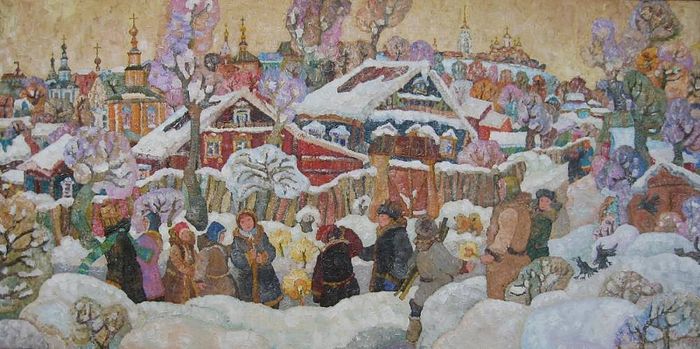 Svyatki in Nicolo Galeiski. Dimtri Kholin. Photo: Picture-Russia.
Svyatki in Nicolo Galeiski. Dimtri Kholin. Photo: Picture-Russia.
There is a special festal period in Christian tradition. It is observed from Christmas Eve (December 24 / January 6) till Theophany (January 6 / 19) included.
Three feasts fall in the Christmas season (Christmastide): Christmas Eve, the Nativity of Christ, and the Baptism of the Lord, or Theophany. These two weeks are a period of merry-making, fun and rest, which may take various forms.
Origins of the traditions
The history of the Christmas season goes back to great antiquity. It is mentioned in the work of the Christian theologian St. Ephraim the Syrian, who died as early as 373, and in the Typikon by St. Sabbas the Sanctified who reposed in 532. In 567, the Church officially proclaimed the twelve days from the Nativity of Christ to Theophany as a sacred and festive season.
What to do during Svyatki
The faithful were instructed to sing of the Nativity and glorify God Who sent Jesus Christ to earth, and attend church services—after all, you won’t spend the whole festive season at the dinner table! Every respectable Christian was expected to attend at least one service during the Christmas season. During this season people would dispense alms among the poor, give presents to children, and help infirm old people more often than during the rest of the year.
The Nativity Fast, or Advent, finishes with Christmas. On the evening of January 6, Christmas Eve, people get ready for the Nativity of Christ which they celebrate on January 7.
On Christmas Eve people prepare a meal of twelve Lenten dishes in the twilight before the first star.1 Traditionally people observed the fast on Christmas Eve even in non-religious families. The Nativity is celebrated on January 7, and meat dishes are included in the family menus on this day.
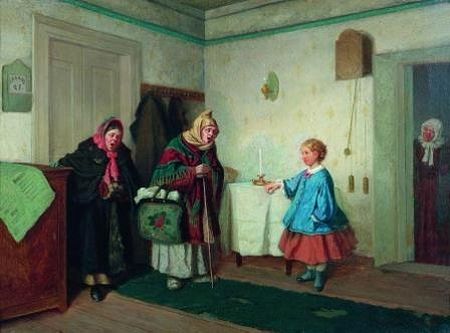 L. Solomatkin. Carollers. 1868.
L. Solomatkin. Carollers. 1868.
Christmas celebrations among Orthodox
Christmas carol-singing is one of the most common customs of the festive season. It is done on the first three days of Christmas (including Christmas Eve, but often beginning from early in the morning of January 7), the first day of the “Old New Year”2 (from late in the evening of January 13 through January 14), and the Eve of the Lord’s Baptism.
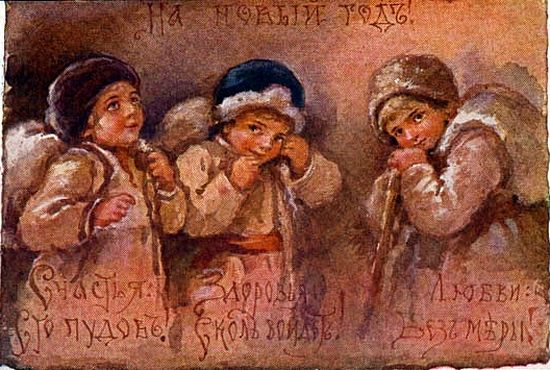 The Christmas season. A postcard
The Christmas season. A postcard
Carol-singing includes the performance of good-natured songs—carols (kolyadki in Russian)—in praise of the Savior’s Birth. As a rule, carolers (mostly children) would practice house-to-house singing in small groups. They could wear costumes of all kinds: various animals or beggars. They would sing songs of congratulations and demand treats after their performances. They would also thank the masters of houses for presents by songs.
Kolyadki are widespread among Ukrainians, partly among Belarusians, and in Russia they can be found only in northern regions in the form of folk songs of praise with the following traditional refrain: “O my vineyard, red and green.”
Not infrequently during their rounds they would perform another festive ritual—“Christoslavlenie” (Russian caroling with the Christmas star). It symbolized the coming of the Magi who heralded the Birth of Jesus Christ. “Russian carolers” (mostly children or young people) would walk in groups of up to fifteen persons in each. By tradition they praised Christ on the first or second day of Christmas. The main attribute of the procession was a small man-made star—a symbol of the star of Bethlehem. “Slavil’shchiki” (Russian carolers) would greet the masters of households with songs, and they in return would give the guests cakes, ring-shaped rolls, spice cakes, or coins.
Christmastide traditions also include the “sowing” ceremony. Village children or shepherds would walk from house to house, carrying grains in their mittens. In the large bright rooms of houses the guests would imitate sowing, repeating the ritual wishes for good and attracting rich harvests. After the rite the hosts would give presents or treats to the “sowers”.
Real plays were performed in many Russian izbas [peasant log huts.—Trans.] during the Christmas season. These were Nativity scenes. In fact they could be called mobile puppet shows that presented the mystery of the Birth of Christ to the viewers. Earthen or wooden angels, the Shepherds and Magi with gifts were used instead of puppets.
Treats during the Christmas season
The main purpose of Christmastide fare among Orthodox was not satiety; rather, food was a symbol of the feast. Spice cakes and pies were served at table, along with the traditional kutya (on Christmas Eve and Theophany Eve). Kutya was usually cooked with whole grain (wheat, barley, millet), with the addition of forest berries and honey. Better off families cooked kutya with raisins and nuts. Guests were also treated to uzvar—a beverage of dried fruit, sweetened with honey.
In January daylight hours gradually lengthen. So housewives would usually bake bliny (pancakes) during the Christmas season as they symbolized light and the sun from ancient times. They would also make cookies called “kolyadki” for Christmas. Their shapes varied, but they were always baked of unleavened dough from rye flour. These cookies were served with kvas [traditional Russian fermented soft beverage, made from rye or barley.—Trans.], tea, or shchi [cabbage soup.—Trans.].
Beginning from January 7 many households would serve roast suckling pig at table—it was considered a symbol of fertility and prosperity. Other meat dainties could be consumed on the feast as well: mutton, wildfowl, hazel-grouse, goose, or chicken.
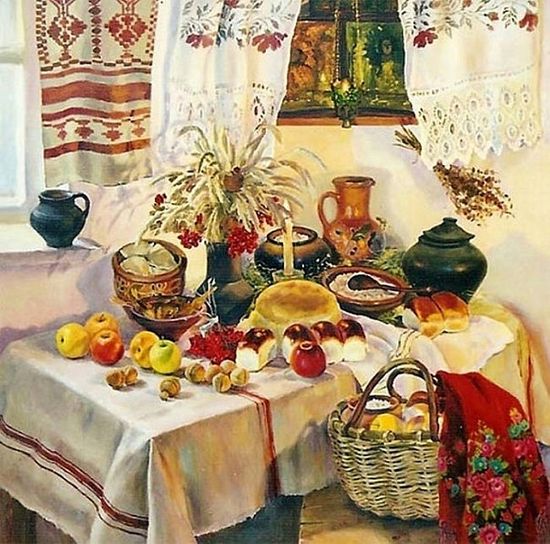 Christmas Eve. A painting by the artist Nadezhda Poluyan-Vnukova
Christmas Eve. A painting by the artist Nadezhda Poluyan-Vnukova
Decoration of houses
Candles were always the main element of home decorations on Christmas Eve. Candlelight symbolized Christ Himself. People would get ready for the feast by stocking up large wax candles that burned for almost a whole day: they were lit at the nightfall and blown out towards the end of the following day.
During the Christmas season peasants would spread straw all over their izbas and place a sheaf in the icon corner. They took care to adorn their gardens too: It was a custom to tie ribbons around fruit trees in the yards. Domestic chickens were fed with festal kutya. All of this was done to attract happiness and prosperity to families.
The Christmas season’s end on January 19
The Christmas season would end on January 19, on the feast of the Lord’s Baptism (other names in Russia: Theophany, “the Day of Jordan”, “Vodosvyatie” (“Consecration of Waters”), “Vodokreshchi” (“Water Baptism”). Orthodox would come to frozen lakes and rivers to plunge into the icy-cold water—for this they would make cross-shaped holes in the ice. Everything around the ice holes was decorated with wooden patterns and colored ribbons. A strict fast preceding Theophany Eve, along with the immersion in the consecrated water, helped people to be cleansed of their sins committed during the Christmas season voluntarily or involuntarily.
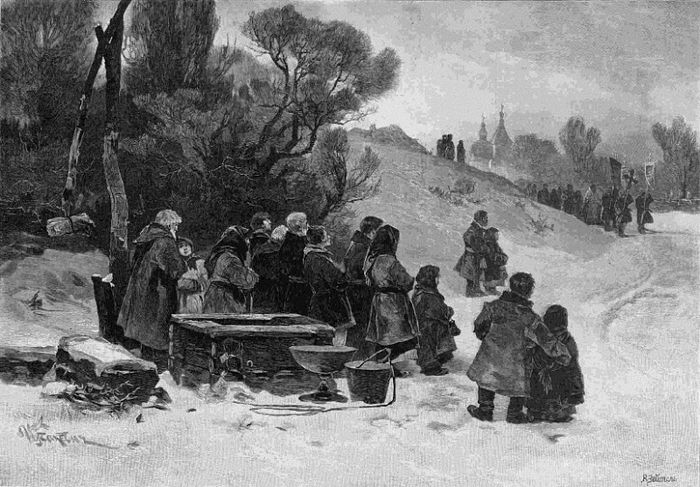 Before the Procession at Theophany. 1898. By an unknown author.
Before the Procession at Theophany. 1898. By an unknown author.

